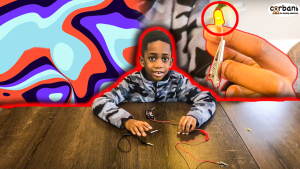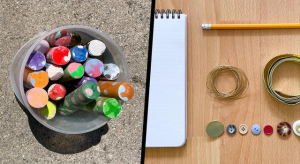Engaging fifth graders in STEM (Science, Technology, Engineering, and Mathematics) activities is an excellent way to foster their curiosity, critical thinking skills, and creativity.
At this age, students are ready to explore complex scientific concepts and hands-on experiments that can ignite a lifelong passion for STEM fields.
These activities not only make learning fun but also help students develop problem-solving abilities and a deeper understanding of the world around them.
We will explore a variety of Stem Activities for 5th Graders, ensuring they have an exciting and educational journey as they delve into the wonders of STEM.
Stem Activities for 5th Graders Paper Airplane Engineering:

One of the most classic and engaging STEM activities for fifth graders is paper airplane engineering. This hands-on project combines principles of physics and aerodynamics. Students can experiment with different designs, wing shapes, and paper types to see how they affect flight distance and stability. Encourage them to make predictions, record data, and refine their designs for an interactive and educational experience. This activity not only introduces kids to fundamental engineering concepts but also nurtures their problem-solving skills.
Solar-Powered Cooker:

Harness the power of the sun by guiding fifth graders through the construction of a solar-powered cooker. This project introduces them to basic engineering and renewable energy concepts. Students can design and build their cookers using materials like cardboard, aluminum foil, and plastic wrap. They can then test their devices by cooking marshmallows or heating water. It’s a fun way to explore environmental science while showcasing the practical applications of solar energy.
Water Filtration Challenge:

Teach fifth graders about environmental science and engineering through a water filtration challenge. Provide them with a variety of materials like sand, gravel, cotton balls, and coffee filters. Their task is to build a water filtration system that can effectively clean dirty water. This activity not only promotes teamwork and problem-solving but also introduces students to the crucial topic of water purification, highlighting its importance for global sustainability.
Related: 21 Exciting Stem Activities for 3rd Graders
DIY Electric Circuits:

Introduce kids to the world of electricity and circuits with a DIY electric circuits project. Using basic materials like wires, batteries, and small light bulbs, fifth graders can create simple circuits to illuminate bulbs or power small devices like a mini fan. Encourage them to explore how different circuit configurations affect the flow of electricity, fostering a deeper understanding of electrical engineering principles in a safe and hands-on manner.
Simulate an Ecosystem:

Create a small-scale ecosystem in the classroom, such as an aquarium or terrarium. Students can choose and research the plants and animals they want to include and learn about the interdependence of living organisms. This project teaches ecology and environmental science concepts.
Egg Drop Challenge:

In the egg drop challenge, students are tasked with designing a container that can protect a raw egg from breaking when dropped from a certain height. This project introduces principles of physics, engineering, and materials science. Fifth graders can experiment with different materials, shapes, and cushioning techniques to create their egg protection devices. It’s a hands-on way to explore concepts like force, gravity, and impact.
Plant Growth Experiments:

Engage students in biology and environmental science by conducting plant growth experiments. Provide them with different types of seeds and guide them in setting up experiments to explore factors that affect plant growth, such as light, water, and soil conditions. This activity allows students to observe the scientific method in action while gaining a deeper understanding of plant biology.
DIY Volcano:

Create a volcanic eruption right in the classroom with a DIY volcano project. This activity combines elements of earth science and chemistry. Fifth graders can construct a volcano model using clay or paper mache and then create a chemical reaction by mixing baking soda and vinegar inside the volcano to simulate an eruption. It’s a fun and memorable way to learn about geological processes and chemical reactions.
Related: 25 Easy Stem Activities for 2nd Graders
Bridge Building Challenge:

Challenge students to build sturdy bridges using common materials like popsicle sticks, toothpicks, or spaghetti. This project introduces principles of structural engineering and physics. Fifth graders can experiment with different bridge designs, lengths, and weights to determine which structure can hold the most weight. It encourages critical thinking and problem-solving skills while exploring the fundamentals of engineering.
Coding and Programming:

Introduce fifth graders to the world of coding and programming through beginner-friendly platforms and tools like Scratch or Blockly. These visual programming languages allow students to create animations, games, and interactive stories by snapping together code blocks. Coding not only promotes logical thinking and problem-solving but also provides an early introduction to computer science and technology.
Weather Station Project:

Set up a mini weather station to help students learn about meteorology and data collection. Equip them with simple tools like a thermometer, barometer, and anemometer (wind speed gauge). Encourage them to record daily weather observations and analyze trends over time. This activity not only teaches about weather patterns but also introduces the importance of data analysis and scientific observation.
3D Printing Creations:

If you have access to 3D printers, students can design and print their own creations. They can learn the basics of 3D modeling software and witness the transformation of digital designs into physical objects. This activity introduces them to technology, engineering, and digital fabrication.
Balloon-Powered Cars:

Engage students in physics and engineering with a balloon-powered car project. Challenge them to create cars using everyday materials like balloons, straws, and cardboard. This activity introduces concepts such as Newton’s laws of motion and aerodynamics while fostering creativity and problem-solving skills.
Solar System Models:

Encourage fifth graders to create scale models of the solar system, helping them understand the relative sizes and distances of celestial objects. They can use craft materials to make models of planets and place them at appropriate distances from a sun model. This project provides insight into astronomy and celestial mechanics, sparking curiosity about the cosmos.
DIY Simple Machines:

Explore the world of physics and engineering by having students design and build their own simple machines, such as levers, pulleys, or inclined planes. Provide various materials like cardboard, string, and small objects for experimentation. Students can learn how these machines make work easier and discover their practical applications in everyday life. This hands-on activity promotes problem-solving and critical thinking skills.
Build a Mini Greenhouse:

Introduce students to botany and ecology by guiding them in building mini greenhouses using clear plastic containers or bags. They can plant seeds and observe how the greenhouse effect works to create a warm and humid environment for plant growth. This activity teaches them about the greenhouse effect, plant biology, and ecosystem interactions.
Water Rocket Launch:

Organize a water rocket launch to introduce students to the principles of physics and engineering. Provide them with empty plastic soda bottles, fins, and a nozzle. Students can design their rockets and use water and air pressure to launch them into the sky. This hands-on activity allows them to explore concepts like force, pressure, and trajectory while having a blast.
Environmental Sustainability Project:

Teach fifth graders about environmental science and sustainability by assigning a project that focuses on a local environmental issue. They can research topics such as pollution, conservation, or renewable energy sources and propose solutions or awareness campaigns. This project encourages critical thinking and empowers students to make a positive impact on their community.
Birdhouse Building:

Combine woodworking skills with biology by having students build birdhouses. Provide them with pre-cut pieces of wood, nails, and paint. This project not only teaches basic construction techniques but also introduces concepts of habitat preservation and ornithology. Students can research the types of birds in their area and design birdhouses accordingly.
Robotics with LEGO Mindstorms:

Introduce robotics and programming using LEGO Mindstorms kits. Fifth graders can build and program their own robots to complete various tasks and challenges. This activity helps them develop problem-solving skills, logical thinking, and an understanding of robotics and automation.
DNA Extraction Experiment:

Introduce students to the world of genetics with a DNA extraction experiment. Using everyday household items like strawberries and dish soap, they can extract DNA strands and observe them under a microscope. This activity provides a hands-on understanding of genetics and the molecular basis of life.
Renewable Energy Wind Turbines:

Explore the concept of renewable energy by having students design and build their own small-scale wind turbines. They can use materials like cardboard, plastic cups, and small motors to create functioning wind turbines. This project introduces the basics of wind energy, engineering, and environmental sustainability.
Coding with Micro:bit:

Engage students in computer science and programming by using Micro:bit, a pocket-sized programmable computer. Students can learn the basics of coding by creating simple games, animations, and projects with Micro:bit. This activity helps them develop computational thinking and problem-solving skills.
Weather Forecasting:

Turn your students into meteorologists by having them create simple weather forecasting tools. They can make homemade barometers using glass jars, balloons, and straws to measure air pressure changes. This hands-on project teaches them about atmospheric pressure and its impact on weather patterns.
Electric Circuit Art:

Combine art and science by having students create electric circuit art pieces. Provide them with LED lights, conductive tape, batteries, and various art supplies. They can design and build artworks that incorporate functioning electrical circuits, teaching them about circuits, conductivity, and creativity.
Related: 20 Fun Ice Breakers for Middle Schoolers

